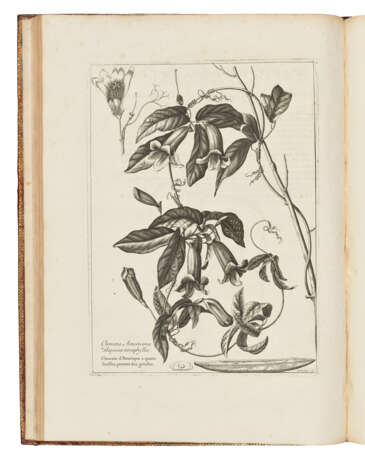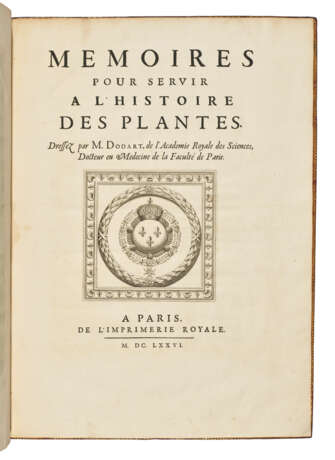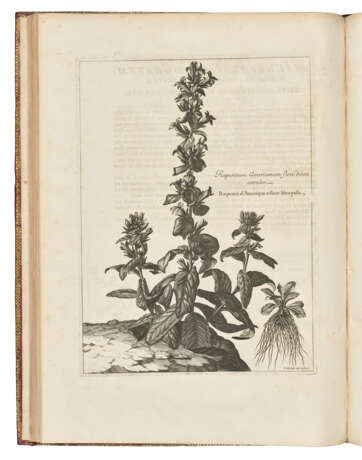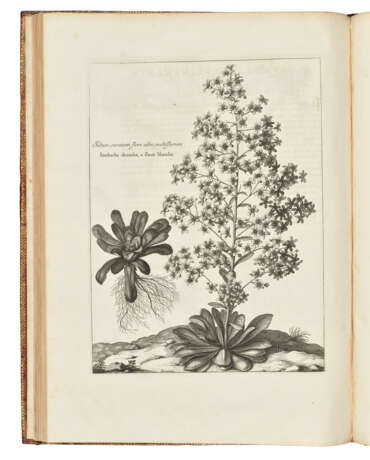ID 1449860
Lot 100 | DODART, Dionys (1634-1707)
Estimate value
£ 30 000 – 50 000
Mémoires pour servir à l'Histoire des Plantes. Paris: by Sebastien Mabre-Cramoisy at l'Imprimerie Royale, [colophon date: 1675-]1676.
First edition of ‘one of the greatest books in the history of botanical illustration, where all the technical resources of engraving were utilized in presenting the plants as accurately as possible’ (Hunt). The Vershbow copy. The Mémoires were born out of the desire of the Académie Royale des Sciences to publish a natural history of plants, an idea first proposed by Claude Perrault in 1667, shortly after the Académie's foundation in 1666. Following Dodart's election to the Académie in 1673, he was charged with the task and prepared the Mémoires pour server à l'histoire des Plantes with other members. The first part (‘Projet de l'histoire des Plantes’, pp. [1]-52) establishes the need for the work and the form of the descriptions and illustrations of the plants, and the second part (‘Descriptions de quelques Plantes nouvelles’, pp. 53-131) comprises descriptions by N. Marchant and illustrations after Nicholas Robert of 39 species ‘dont la pluspart sont rares, & n'ont jamais esté ny décrites, ny figureés' (p. 53), in accordance with the structure proposed in the first part, describing the plants, their attributes, and the sources of the specimens.
The remarkable full-page illustrations were engraved from drawings by Nicolas Robert (1614-1685) ‘made for the most part from life; in the case of several rare plants, he was obliged to adapt paintings which he had previously made on vellum at the Jardin du Roi. Robert in his Fiori Diversi and more particularly in another volume entitled Diverses Fleurs (c.1660), had already shown his skill as an engraver. In this more exacting task he was now assisted, or perhaps directed, by the engraver Abraham Bosse’ (Blunt, p. 122). ‘Dodart’s preface to the Mémoires clearly indicates that botanical accuracy was the foremost requirement. He directed that plants were to be portrayed in life size, shown in two such sections if not more than twice the page height; if even larger, then some portion of the plant was to be shown in natural size’ (Gavin D.R. Bridson and Donald E. Wendel, Printmaking in the Service of Botany..., Pittsburgh: Hunt Institute, 1986, item 16). The plates were intentionally presented in monochrome, due to the shortcomings of colourists, as the preface explains: ‘Since printing in colour is not employed yet, and since painters waste much time and are not always successful, we thought we could, in future, supply to some extent what was lacking in an engraving, by taking care to indicate, as far as is feasible, the depth of the colour. Thus a distinction would be made between brownish-green and pale green, between white and dark-coloured flowers..’ [trans.]. These techniques led to images of such remarkable beauty and quality that ‘numerous authorities agree that Dodart's plates rank among the best botanical engravings ever produced’ (Bridson & Wendel). BM(NH) IV, p.1515; Brunet II:785; Graesse II:415; Hunt 343; Nissen BBI 502; Pritzel 2341.
Broadsheet folio (548 x 406 mm). Letter-press title with engraved vignette. Engraved frontispiece of the Académie by and after Sebastien Le Clerc printed by Goyton, 39 engraved full-page illustrations (28 by and after Nicolas Robert, 11 by Abraham Bosse after Robert), engraved head-piece, tail-piece and initial. Accompanied by 5 additional engraved plates (see below). (Some occasional pale spotting and browning, a few small stains, letter-press title on p.83 partially cancelled in ink). Contemporary French gold-tooled red morocco, spine in eight compartments with seven raised bands, black morocco lettering-piece in one, repeated floral design in the remaining, edges gilt (some wear at ends of spine, a few repairs on sides). Provenance: Thomas Philip de Grey, 2nd Earl de Grey (1781-1859, Conservative politician; Wrest Park bookplate); Lucien Goldschmidt, sold in 1964 to – Arthur and Charlotte Vershbow (bookplate); their sale, Christie’s New York, 20 June 2013, lot 487.
Of the five additional plates that accompany this copy, three appear in the work (those on Nn, Ooo [repeated on Ppp] and Qqq), but without the text on the verso. The two remaining plates of Tithymalus Americanus nodifloris and Aster Verbasci folio were apparently intended for the work and engraved by Louis de Châtillon. All are uncut. BM(NH) IV, p.1515; Brunet II:785; Graesse II:415; Hunt 343; Nissen BBI 502; Pritzel 2341.
| Place of origin: | Western Europe, France, Europe |
|---|---|
| Auction house category: | Books and manuscripts, Printed books |
| Place of origin: | Western Europe, France, Europe |
|---|---|
| Auction house category: | Books and manuscripts, Printed books |
| Address of auction |
CHRISTIE'S 8 King Street, St. James's SW1Y 6QT London United Kingdom | |
|---|---|---|
| Preview |
| |
| Phone | +44 (0)20 7839 9060 | |
| Buyer Premium | see on Website | |
| Conditions of purchase | Conditions of purchase |








